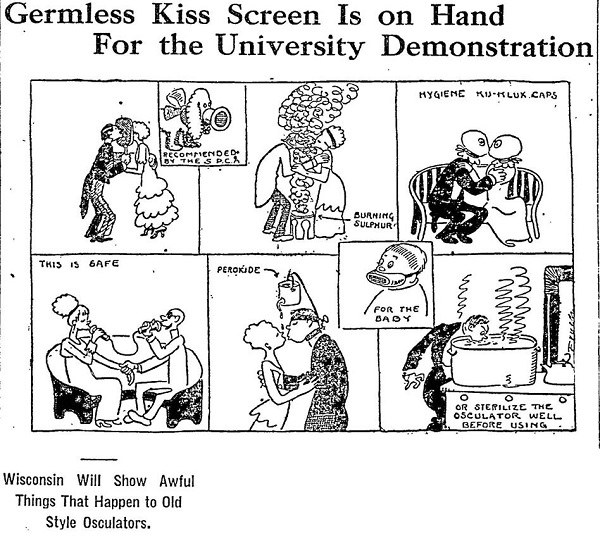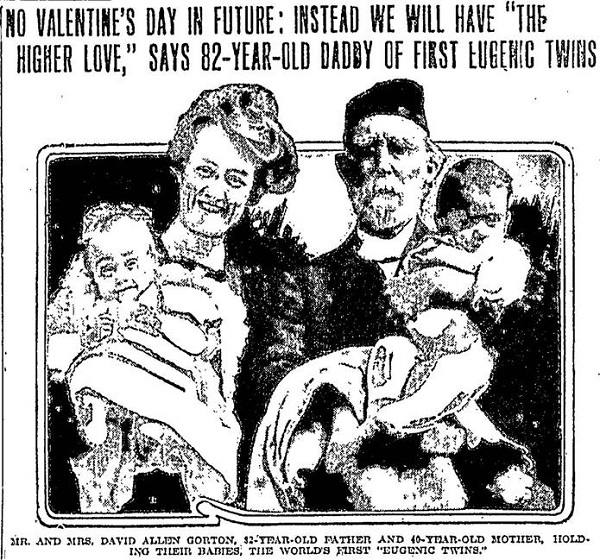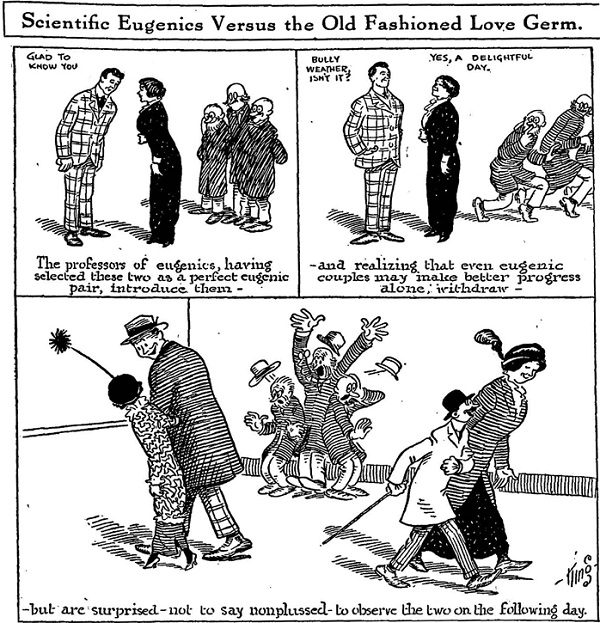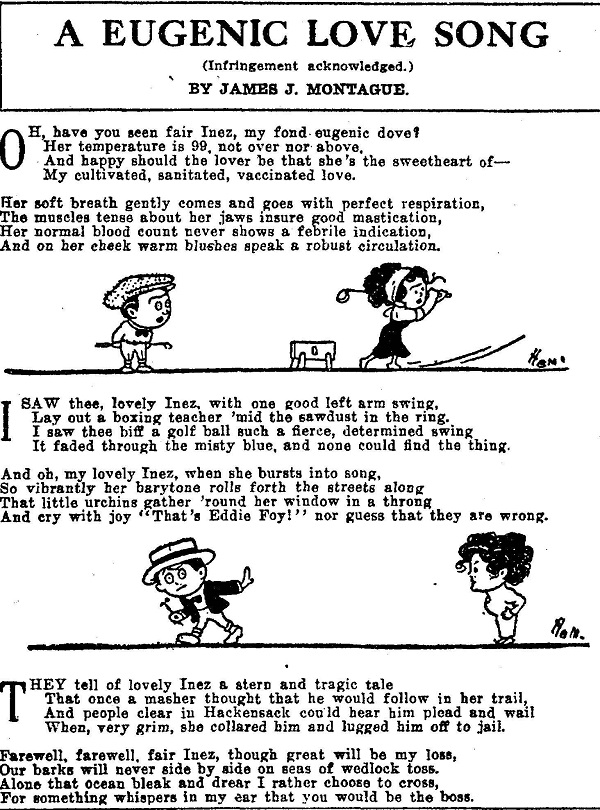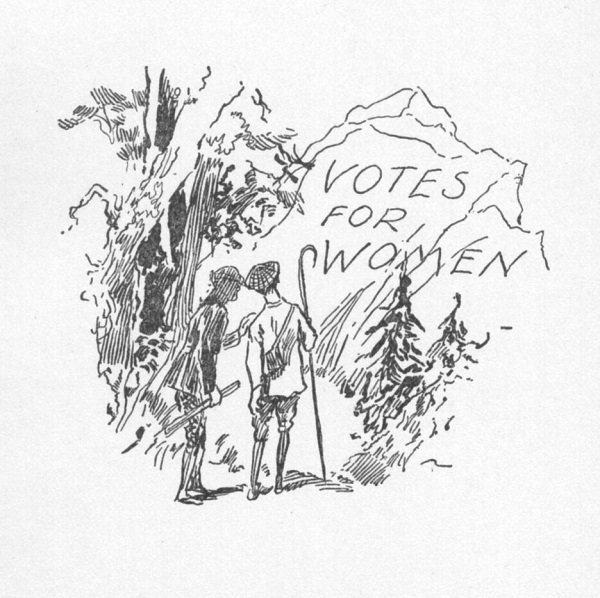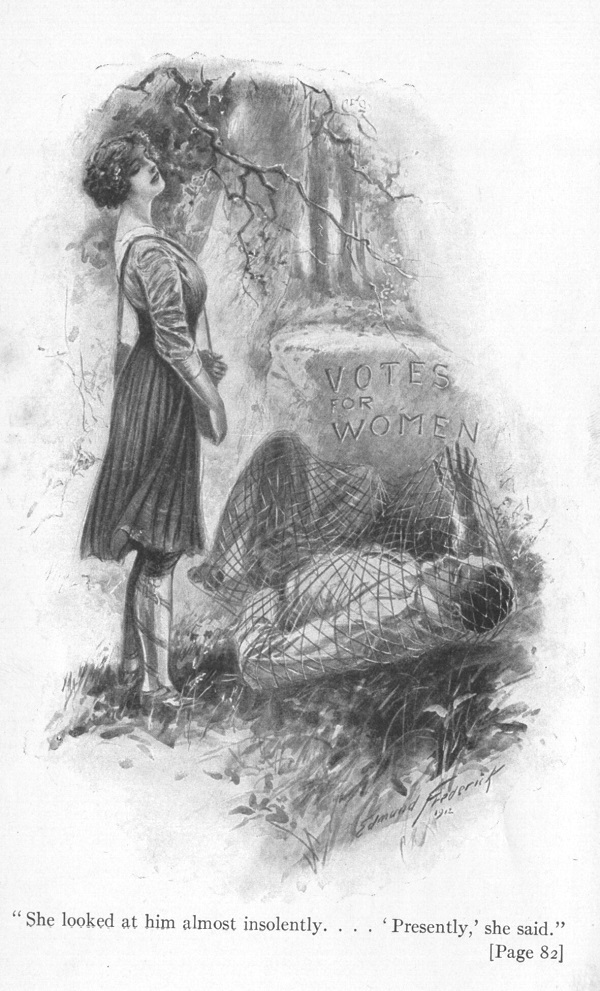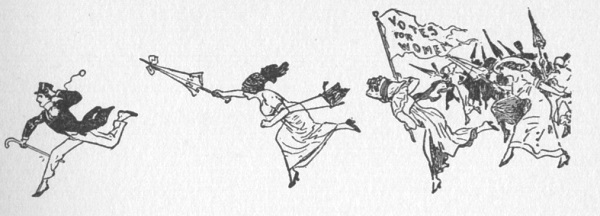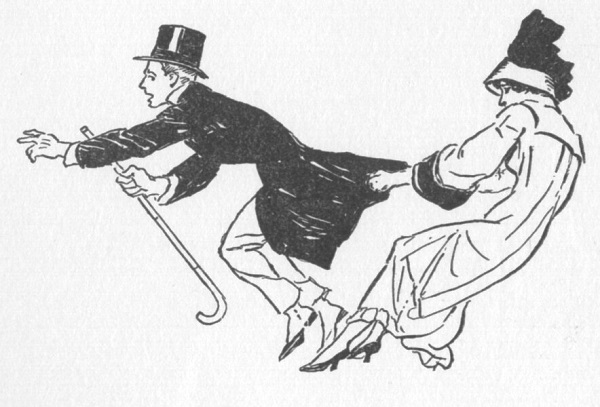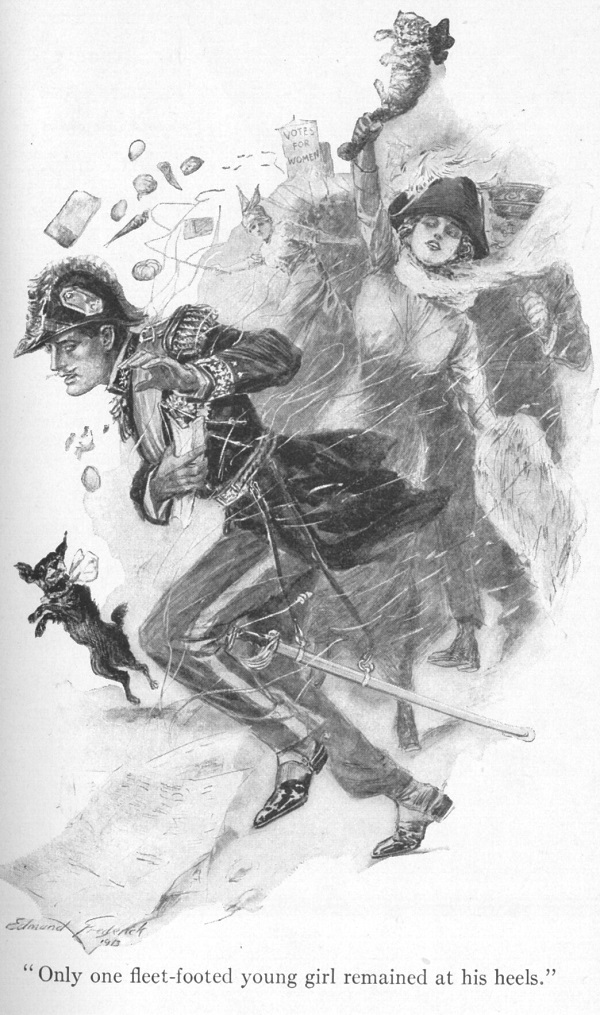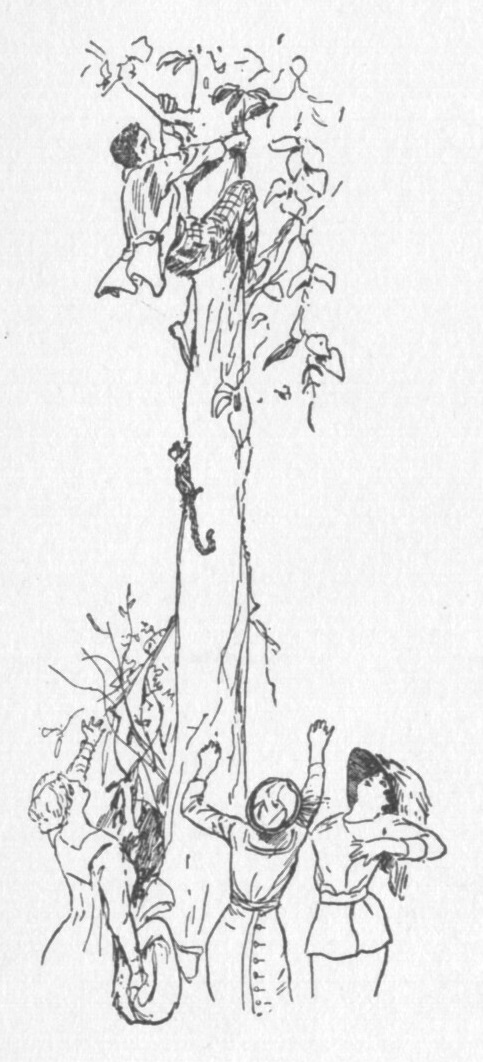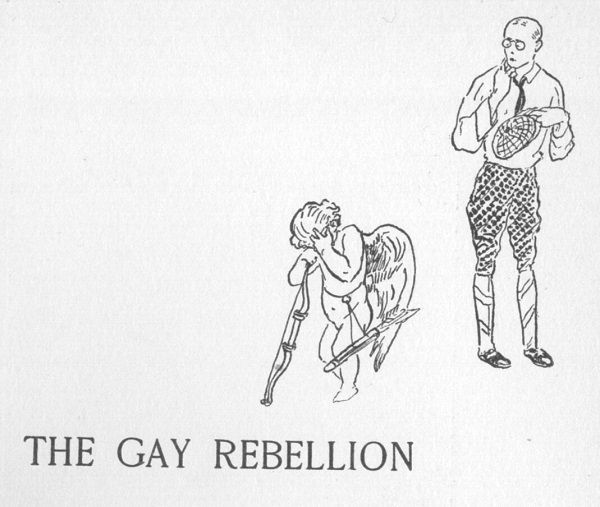On February 21, 1915, the Chicago Tribune ran an appeal to readers for letters describing their experiences falling in love. With the promise of $1 for every letter published, the newspaper asked its audience to describe what attracted them most to their beloved. “Was it a wayward curl, a roguish eye, a dimple or an alluring smile? …Was it the pies she made or the flowers he brought? …Was it the possibility of a eugenic ideal?” From a modern perspective, the last question seems at odds with the first two. While the former focus on the attractiveness of an individual, either by physical features or by deeds, the latter focuses on the appropriateness of the match. The former are whimsical in tone and allude to the mystery of romance; the latter is clinical in its presentation of love as a decision-making process guided by specific goals, principles, and values. Viewing eugenics as a sort of OkCupid of the Progressive Era might be a bit surprising, especially given the predominant focus of eugenics historiography on involuntary sterilization, race suicide, and immigration restriction.[1] But a closer look at the popular reception of eugenics in the [End Page 1] US reveals an early fascination with how eugenics would make love, romance, and marriage scientific.[2]
As Alexandra Stern notes in her history of the eugenics movement in California, “placing gender and sexuality at the center of the analysis reconfigures the history of eugenics, demanding substantial temporal and thematic revisions” (7). Eugenics entered the American popular discourse in the first decade of the twentieth century—a critical juncture of changing sexual attitudes and gender relations. As Kathy Peiss documents, white middle-class Protestants were concerned about the influence of working-class sexual mores, like petting, treating, and dating, that were becoming fashionable in urban centers. Many middle-class reformers recoiled in horror as young people danced the Bunny Hug and the Grizzly Bear. Mary Odem charts how reform efforts aimed at eliminating prostitution and venereal disease resulted in the policing and regulation of working-class women’s sexuality in the early twentieth century (96-98). As Wendy Kline argues, the eugenics movement was preoccupied with the reproductive decisions of “fit” and “unfit” women and sought to instill a “‘reproductive morality’ into the public consciousness” (2). Sterilization and segregation of women who were labeled feeble-minded were central features of the eugenics movement in the Progressive Era.
But, as Colin Johnson notes, much of the historiography disproportionately presents eugenics as a “one-sided attempt to exercise power over and against particular segments of society—the poor, the ‘feeble-minded, immigrants, people of color, and so on” (28). Instead, Johnson recasts the eugenics movement within the broader history of American sexuality as a robust public discussion about sex and reproduction that “enfranchised ‘normal’ Americans with the power and responsibility to ‘cultivate the race’ in the same way that they might cultivate a tomato plant” (28). Laura Lovett furthers this claim by examining how the rhetoric of ‘race suicide’ was used to push pronatalism for middle-class white women in the United States. This article adds to the historiographic exploration of eugenics and American sexuality by examining the discourse around love and romance in the eugenic vernacular of the early twentieth century.[3] As one proponent explained, “love can, among normal people at least, be ordered” (Eugenics, 178). In a cultural moment where many worried that love and courtship had become wanton, depraved, and libidinous, eugenics promised order, efficiency, and control.[4]
Steeped in the scientism of the age, Americans in the Progressive Era were expected to assert self-control and apply the dictates of scientific experts to all aspects of their lives. In the same way that Americans were encouraged to eat rationally based on the new insights of nutrition science, they were also encouraged to love rationally based on eugenic considerations.[5] Examining the eugenic vernacular reveals how eugenics was popularly understood as a sexual science, i.e. a program for changing the relations of the sexes in order to improve future generations of humanity.[6] Proponents of this view of eugenics were determined to instill a eugenic conscience in young people, particularly college-educated women. The focus on women’s role in mate selection connected eugenics in the public consciousness with the rise of the New Woman and the emerging feminist movement. This article breaks new ground by revealing the gendered anxieties underlying popular anti-eugenics sentiment.
In 1904, Francis Galton unveiled his vision of a new science of good breeding that he called eugenics at the newly founded English Sociological Society (Life, Letters 259). Americans were then introduced to eugenics through newspaper coverage of Galton’s talk [End Page 2] that originated with the London Express but was subsequently reprinted and paraphrased. These articles laid the groundwork for how the American public would come to perceive eugenics as a sexual science. One quote from Galton’s address became emblematic of the goals of eugenics. As the Anaconda Standard described it, “Dr. Galton, in explaining this science, which he may have said to have invented, said ‘The passion of love seems to be so overpowering that it may be thought folly to try to direct its course. But plain facts do not confirm this view. Social influences have immense power. If suitable marriages, from the eugenic point of view, were banned socially, few would be made” (“Society to Study Heredity” 2). The Montgomery Advertiser included discussion of the new “love-regulating science” of eugenics alongside other “Scientific Miscellany” such as improvements in microscope technology and experiments in nutritionally enhanced vegetables. Similar to the other news coverage, the Montgomery Advertiser explained, “It [eugenics] will strive to regulate the passion of love, absurd as this may seem, and much toward this is expected from placing a social ban on unsuitable marriages” (“Scientific Miscellany” 18). From the beginning, then, eugenics was presented as a scientific program for modernizing love and marriage. Romantic love needed to be shaped, controlled, and rationalized so that Americans would only marry and reproduce with suitable matches.
Further complicating the newspaper coverage of the new science of eugenics was the inclusion of George Bernard Shaw’s comments on Galton’s address to the Sociological Society. Both Shaw and H.G. Wells attended Galton’s lecture and offered support for his ideas as well as some measured critiques. Wells actually pointed out to Galton that eugenics was just a new word for stirpiculture and had been popular in America for decades, especially among sex radicals (Life, Letters 259). Shaw offered more unqualified support, enthusing that “there was now no reasonable excuse for refusing to face the fact that nothing but a eugenic religion can save our civilization.” However, Shaw quickly moved beyond Galton’s rather modest reforms for encouraging ‘suitable’ marriages, boldly declaring “what we must fight for is freedom to build the race without being hampered by the mass of irrelevant conditions implied by marriage” (Life, Letters 260). But the quote from Shaw that was picked up for American newspaper coverage of eugenics was his quip about the haphazard nature of selecting spouses: “In spite of all the romances, men and women are amazingly indiscriminate in their attachments; they select their wives and husbands far less carefully than they select their cashiers and cooks. I am afraid we must either face a considerable shock to vulgar opinion in this matter or let eugenics alone” (“Society to Study Heredity” 2). Shaw was already well known in the US as a critic of the sexual double standard, institutionalized marriage, and American “Comstockery” (Shaw 5). Therefore, the inclusion of his comments alongside Galton’s served not only to reinforce that eugenics was a science concerned with reforming love and marriage, but also hinted that eugenics merged well with the ideology of sex radicals, who had for decades discussed how voluntary motherhood and free love would improve the race.[7] In fact, as William Leach documents in True Love and Perfect Union, late nineteenth century American feminists had been arguing for decades for a more rational approach to love as an alternative to what they saw as the pitfalls of Victorian sentimental culture (112). Because of this late nineteenth century context, eugenics was fused with the connotation of women’s empowerment, especially sexual selection of mates, from the beginning.[8] This explains why, when the word “eugenics” first appeared as an entry in the Century [End Page 3] Dictionary in 1904, the definition stated, “the doctrine of progress or evolution, especially in the human race, through improved conditions in the relations of the sexes.”
As it was described in American newspapers, eugenics was consistently presented as a scientific approach to love and relationships. The Duluth News-Tribune predicted that eugenics would eradicate the “reckless thoughtlessness of youth” and the “impulsiveness of love-at-first-sight” and replace it with “the wholesome influence of sober and thoughtful conscience in courtship” (“Science of Eugenics 6). Noting approvingly that the “new science of eugenics has therefore been evolved to direct and regulate the force of romantic love,” the article went on to envision a future where young men and women would carry around eugenic certificates that attested to their hereditary and physical fitness (6). Taking this to absurdist lengths, the article teased that the imagined couple might then seal their engagement “not by a microbic kiss, but by swapping documents” (6). Playing on this theme of sanitizing love and making sexual acts hygienic, a cartoon that was featured with an article on Wisconsin’s eugenic marriage law showed various methods for disinfecting kisses.
The Macon Daily Telegraph also had similarly harsh words about love at first sight, calling it “always in error” (“Love at First Sight” 8). Eugenics, as the editorial explained it, [End Page 4] was not opposed to love, but would instead help set the “boundaries of love” by “forming new channels through which love may flow” (8). As examples of the eugenic boundaries of love, the article approvingly noted that “[p]eople do not tend to fall in love with those who are in racial respects different in contrast to themselves; they do not tend to fall in love with foreigners; they do not tend to be attracted to the ugly, the diseased, and the deformed; nor do they, as a rule, fall in love out of their own class” (“Love at First Sight” 8). The author insisted that it was important to get these eugenic ideals instilled so that people would “love in the right direction, if not at first sight” (8). For this author, eugenics functioned to reinforce existing social mores and to strengthen them with the imprimatur of science.
But for others, eugenic love was a brand new innovation for the modern age. Dr. David Allen Gorton was an 82 year-old doctor who was so enthralled with eugenics that he selected a woman to marry purely on her presumed fitness. Newspaper coverage of Gorton relied on a common Progressive Era trope of the scientist so invested in his research that he would sacrifice himself for the greater good.[9] Gorton became the father of “eugenic twins” and used his public platform to declare that Valentine’s Day would no longer be celebrated in the future. He pronounced the end of “love as we know it—the silly, unscientific love celebrated by penny romances and concoctions of lace paper and gauze ribbons.” In its place would be a “higher love, which will be born of the logical mind and not of the fluttering heart” (“No Valentine’s Day” 20). He minced no words by going even further, declaring that “romantic love leads to ill-considered unions and so is responsible for all the pauperism, for all the disease, and for all the crime that burdens the world” (20).
He then confidently predicted that “the breeding of children under a regime of scientific love, rather than a regime of redheart, paper lace love, will solve all our great social problems” (“No Valentine’s Day” 20). For Gorton then, eugenic love did not just reinscribe pre-existing romantic customs, but completely replaced an antiquated system that was irrational and dysgenic.
As Francis Galton had hoped, eugenics in America became like a new religion, with its own set of moral precepts and codes of conduct. Central to this movement was the development of a eugenic conscience among young people that would compel them to take into account hereditary fitness when choosing a mate. Eugenic experts who lectured at college campuses reinforced this vision of eugenics. In a collection of twelve university lectures given on eugenics from the 1910s, a consistent theme was the rationalization and control of love and romance. Harvey Ernest Jordan, in a lecture to the University of Virginia, dismissed criticisms of eugenics as “this perennial ‘human stock farm’ idea” and instead explained “[e]ugenics recognizes love of the highest and noblest quality…But it would have love intelligent” (Eugenics 111, emphasis in original). Arthur Holmes, speaking at Pennsylvania State College, stated that “[e]ugenics does not teach marriage without love, but it does suggest the Herculean task of commanding love” (Eugenics 178). Charles Davenport stressed the same point: “The general programme of the eugenist is to improve the race by inducing young people to make a more reasonable selection of marriage mates, to fall in love intelligently” (Eugenics 235).
Calls for an ordered love found strong support among women’s rights reformers, who saw in eugenics an opportunity to empower women with the power of scientific mate choice. Popular news coverage reinforced the notion that prominent women were leading the way to enact eugenic social reform. The Lexington Herald covered the founding of a new eugenics society endorsed by Washington society women, including “Mrs. Woodrow Wilson, Mrs. William Jennings Bryans, and Mrs. John Hays Hammond.” The new organization, called the National Society for the Promotion of Practical Eugenics, established several goals, including sex education for children and the segregation or sterilization of the unfit. Primarily, though, the founders of this organization emphasized that women should “have a voice in the selection of a mate” and that men should have not just “worldly capital alone, but biological capital” in order to be marriageable (“Eugenics Now Society Work” 2). Dr. Elizabeth Hamilton-Muncie, a sex hygiene lecturer for the New York State Department of Health, instructed young people to “love with their eyes open and their brains active” (“Won’t Banish Cupid” 4).
While presumably both men and women were expected to develop a eugenic conscience and to learn to fall in love wisely, popular eugenic literature emphasized that women, particularly college-educated women, must take the lead in this endeavor. Then, as Scott Nearing explained in Woman and Social Progress, “[a]s the demand grows, —and it is growing,—men will be compelled to meet the requirements of the college-woman standard” (113). Building on this vision of eugenics was La Reine Helen Baker, who wrote a popular treatment that had wide circulation. As she explained it, eugenics was primarily based on “the union of equality [between the sexes], two citizens joining together in love and wisdom” (97). Each of these popularizers, and several others, connected eugenics with the goals of feminism: namely, the equalizing of the marriage relation, the elimination of the sexual double standard, and, in many cases, voluntary motherhood. But none of these [End Page 6] popular writers had as much impact on shaping the eugenic vernacular as Charlotte Perkins Gilman.
In 1910, Charlotte Perkins Gilman was considered one of the foremost American feminists.[10] In her magazine The Forerunner, she published Moving the Mountain, which she called a “short-distance utopia”, i.e. a novel that took place only thirty years in the future when the New Woman had taken over American society. As Gilman explained it, the world of the future where the New Woman ruled was thoroughly utopian, in large part because New Women were now empowered to institute a comprehensive system of eugenic reforms. The New Woman would revolutionize reproduction by making mating, pregnancy, birth, and child rearing scientific. The New Woman would no longer settle for a man of dubious genetic worth, but would instead claim the power of sexual selection to drive the species forward. Gilman’s work helped to solidify the belief that eugenics entailed the New Woman creating a new breed of man. The double standard of morals would be vanquished and men would be subject to a uniform eugenic standard.[11]
Thus, as it was discussed colloquially, eugenics was increasingly presented as part of a battle of the sexes discourse in the Progressive Era. Anxieties about the changing status of women became fused with fears of the presumed eugenic reforms that they would implement. Many traditionalist men and women spoke out against the sanitized trend in courtship and pleaded for a return to a more natural, or divine, order. They connected the demands of feminism with the calls for a more scientific approach to love, and accused feminists of treating men like livestock. The eugenic standard that the New Woman was expected to uphold was pilloried widely in fiction, film, and newspaper editorials.
Much of the anti-eugenic sentiment simply took the form of rejecting modern science by defending common sense and tradition from the intrusions of self-appointed Progressive Era experts. One man complained in an anonymous editorial that “[t]he professors of the new science of eugenics would have us believe that the custom of marrying for love is a mistake” (“Scientific Marriage” 3). He insisted that based on his observations, “the choice of a wife on philosophical principles is most certain to end in failure” (3). Rather than listening to so-called experts, he passionately argued that a man should trust his instincts. The poet Franklin Pierce Adams also mocked the idea that love should be ruled by scientists. In his poem “Eugenic Love Lyrics,” he satirized the decidedly unromantic vision of eugenic love with the refrain “Eugenevieve, Eugenevieve, The days may come, the days may go/But to each other we shall cleave, As long as Science tells us so” (120). The unhappy couple in the poem has a relationship built on clinical details, but no real emotions. The poem then concludes with the children of the couple rejecting the parents when they find out that they were merely the results of a breeding experiment. [End Page 7]
An example of the resistance and mockery of eugenic experts is seen in the image above. The professors of eugenics try in vain to make a perfect match, but are thwarted by good old-fashioned love, which is haphazard and unpredictable. The man and the woman both wind up with people who are physically dissimilar to them, to humorous effect. Another frequently used trope was to pit eugenics against Cupid, or as the Morning Oregonian mused, “Is the magical touch of Dan Cupid…to run second fiddle to the betterment of the race?” (“Ascendancy of Eugenics” 8). In the popular discourse, Dan Cupid was depicted as the archenemy of eugenics, doing battle for the hearts of men and women in a cold-blooded scientific age. Still other critiques invoked the Divine in opposition to making love and marriage scientific. An anonymous editorial in the Wilkes-Barre Times Leader declared that “[e]ugenics is a new name for an old folly…that men can be bred as animals are bred, by rules adopted by men.” What this vision left out, according to the author, was the divine spark that guided two people together. The author continued, “When two people love each other, God has said to them that their children are demanded…Romance may not be important to the professional mind, but the great peoples of the world are those to whom children are born as the culmination of romances” (“Eugenic Marriage” 18). And for others, ignorance was preferable to cutting edge scientific knowledge, especially when that knowledge was construed as sexual knowledge. A folk wisdom column from the Cincinnati Enquirer fumed, “They can teach eugenics in the public schools and get away with it. But the old-fashioned boy who believed in the stork until he was 16 years old always managed to make a pretty good citizen” (“Luke M’Luke Says” 6). [End Page 8]
While much of the anti-eugenic sentiment took these forms, eugenics was more commonly connected with women’s empowerment and both were critiqued together as two sides of the same coin. Much of this kind of anti-eugenics sentiment took on a sexist bent that connected eugenics to overbearing and masculinized women. An illustrated poem in the Salt Lake Evening Telegram entitled “A Eugenic Love Song” made this point with a young man enamored initially by the lovely Inez, his “fair eugenic dove” with whom he was excited to experience “cultivated, sanitated [sic], vaccinated love.” But soon the suitor realizes that Inez is too domineering and has even imprisoned a previous man who courted her. Implying that eugenic love entailed a subversion of gender roles, the suitor abandons Inez for fear that if he married her she “would be the boss” (11).
But perhaps the clearest example of the gendered nature of opposition to eugenic love and marriage is seen in The Gay Rebellion (1913), a novel written by Robert Chambers. Chambers, while most well-known for his 1895 collected volume of Gothic short stories, The King in Yellow, was one of the most popular writers of romantic fiction in the early twentieth century (Cooper 68). With a series of best-selling society novels that began with The Fighting Chance in 1906, Chambers earned a reputation for spinning stories that appealed to the modern woman, leading H. L. Mencken to dub him “The Boudoir Balzac” (Mencken 129). The Gay Rebellion is a satirical novel about a hostile feminist revolution in the United States. The feminists in the novel begin their revolution with the founding of the “New Race University and Male Beauty Preserve” (59). Hidden within the Adirondacks of New York State, the headquarters of the revolution is discovered by two male reporters, Langdon and Sayre, charged with investigating the disappearance of “four young and wealthy men who have…suddenly and completely disappeared” (12). Upon entering the forest, the two men discover messages carved on boulders saying “Votes for Women” (22).
After a few days without any further clues, Sayre spots a “young girl in full war paint and a perfectly fitting gown” named Amourette, who informs him that the men were captured by force, trained at the New Race University, and are now happily married to women as part of the eugenic revolution (27). Sayre scoffs with incredulity, claiming, “women don’t run men off like cattle rustlers. Man is the active agent in elopements, women the passive agent” (50). Rushing back to tell his friend Langdon, Sayre describes the New Race University as “a reservation for the—the p-p-propagation of a new and s-s-symmetrically p-p-proportioned race of g-g-god-like human beings! It’s a deliberate attempt at cold blooded scientific selection” (60). The objectives of this revolution, as explained by Sayre, illustrate the conflation of women’s empowerment with eugenic mating and improvement: “Their object is to hasten not only political enfranchisement, but the era of a physical and intellectual equality which will permit them to mate as they choose and people this republic with perfect progeny” (61-62). Sayre and Langdon forge a plan to capture one of these militant suffragettes by force, but the plan backfires and Langdon is netted and taken prisoner. His captor, Ethra, explains to him, “We women have now decided to repeople the earth scientifically. We shall pick out, from your degenerate sex, such physically perfect individuals as chance to remain; we shall regard our marriages with them as purely scientific and cold-blooded affairs” (87-88).
Langdon’s discomfort with this plan of eugenic breeding clearly stems from its subversion of men’s and women’s roles: “My position is undignified! Anybody’d think I was a prize animal. I don’t like this poultry talk! I’m a man! …And if ever I marry and p-p-produce p-p-progeny, it will be somebody I select, not somebody who selects me!” (89, emphasis in original). Langdon is assessed by the Regents and given a conditional yellow ribbon for his hereditary worth. When he protests, he is told by one of the Regents that “it is a scientific matter to be scientifically recorded—purely a matter of eugenics” (112). The Gay Rebellion revels in the subversion of gender roles to comedic effect, but the underlying fear of impending loss of masculine privilege is palpable. The novel is illustrated throughout with scenes of men being chased and attacked by women.
As Chambers described it, “No young man who conformed to the standard of masculine beauty set by the eugenist suffragettes was safe any longer. Scientific marriage between perfectly healthy people was now a firmly established principle of the suffragette propaganda” (174). Tapping into broader anti-eugenic sentiments, the novel’s title page shows a devastated Cupid, with a frightened and enfeebled young man cowering behind him. [End Page 13]
But ultimately, Chambers ends his novel with the traditional gender order being restored when hordes of men and women who were declared unfit rebel against the new eugenic order and bring down the feminist revolution.
Chambers was not alone in expressing eugenic anxieties about the consequences of women’s newfound freedom and self-actualization. In a piercing essay entitled “The Blushful Mystery,” H. L. Mencken asked whether romance could “survive the deadly matter-of-factness which sex hygiene and the new science of eugenics impose?” (200). The Gay Rebellion illustrated a key facet of the eugenic vernacular in the 1910s: the concern that the New Woman would demand a better, more eugenic, man. In addition to the loss of masculine privilege in the realm of sexual selection, men would be subject to objectification and scrutinized for their health, vigor, and hereditary worth. Within this eugenic vernacular, it seemed that the balance of power in Progressive Era America was decidedly shifting to women.
Martin Pernick has noted similar themes running through early American films that discussed eugenics. In the 1914 comedy Eugenics and the Bar ‘U’ Ranch (Selig 1914), the character named Martha is the eugenics enthusiast who heads out west to find a suitable male specimen. Similarly, in the same year, in Wood B. Wedd and the Microbes (Edison [End Page 14] 1914), the protagonist Wedd is told by the woman he wants to marry that he must first pass a rigorous series of eugenic tests. The tests included various poking and prodding, culminating in a three-hour steam bath, at which point he quits wooing her. The same theme runs through Eugenics versus Love (Beauty 1914), A Case of Eugenics (Vitagraph 1915), The Eugenic Boy (Thanhouser 1914), and A Foe to Race Suicide (Kleine 1912). Based on his survey of eugenic comedies, Pernick concluded that “eugenics is depicted as something imposed by emotionless professionals and rich fanatics, often women, in conflict with the feelings and choices of working-class men” (131).
The gendered anxieties about eugenics were not entirely unwarranted. Women’s reformers advocated vehemently for eugenic marriage laws during this period, requiring a medical certification of health before issuing a marriage license. Professional eugenicists derided these laws, believing them to be not eugenic at all because the medical examinations necessary for certification only tested for venereal disease. Charles Davenport tried in vain to insist that “eugenics is to be distinguished from sex hygiene” and even went as far as to suggest that these laws could cause “many young women of good stock to fear the consequences of marriage, to refrain from it, and so to fail to perpetuate their excellent traits” (Eugenics 1). Nevertheless, women’s reformers across the country eagerly lobbied for eugenic marriage legislation and saw these laws as a central component to women’s advancement. In 1913, Jane Addams was interviewed by a Chicago newspaperman who asked her what the most important women’s issues of the day were. She replied, “I favor strict eugenic marriage laws and woman suffrage.” (“Fashions Not Degrading” 9). Charlotte Perkins Gilman even volunteered to act as a judge in a eugenic marriage contest sponsored by the Medical Review of Reviews in 1915.
Significantly, a survey of the major anti-feminism screeds of the 1910s reveals a strong anti-eugenic sentiment. Benjamin Hubbard’s 1915 tract, Socialism, Feminism, and Suffragism: The Terrible Triplets, Connected by the Same Umbilical Cord and Fed by the Same Nursing Bottle devotes special ire to the eugenic endeavors of feminism: “They [feminists] have changed the word marriage to ‘eugenic mating’ and the bearing of children to ‘breeding’” (215). Similarly, Frederick Merckx’s Bolshevism of Sex warned of “the appointment of women inspectors of eugenics, who would have power to prohibit a man from procreating children, and would have him sent to prison, and his wife on the operating table, if he transgressed their orders…One may ask what has become of the manhood of the country if the nonsensical principles of WOMEN are written into laws” (185, emphasis in original). An editorial in the Waterloo Evening Courier explained, “A feminist state may be altogether just and perfectly eugenical. But it will be a hard scientific system from which love and loyalty will be lost.” This editorial went on to threaten that men would violently resist such an imposition: “Urge feminism too far, smash the home, bring your children up like brooded stock, banish love, and such a terrible masculinism may arise as we have not seen since cave days. The brutal fact is that man is the master of the sexes” (“Feminism Again,” 4). Felix Grendon described a character in his novel as a “young woman [who] seemed a walking embodiment of Votes for Women, Eugenic Marriages, Birth Control, Equal Incomes, Free Divorce, and other monstrous fruits of the unchecked growth of female madness in a feminist epoch” (107). Making love and marriage scientific for these opponents seemed a grave threat to not only the institution of marriage, but to the entire social fabric. That anti-eugenic sentiment was so closely tied to anti-[End Page 15] feminism adds a provocative new dimension to the emerging history of the First Red Scare.[12]
Whether viewed positively or negatively, modernizing and rationalizing love was understood to be one of the central goals of eugenics in the early twentieth century United States. The close examination of so many disparate cultural ephemera provides a finer-grained picture of how eugenics was woven into the public consciousness. Seeing eugenics as a sexual science highlights the ways that everyday Americans in the Progressive Era felt pressured to adapt their own romantic and sexual choices according to eugenic dictates. For some, eugenic love was embraced because it held the promise of a scientific match, guaranteeing life-long happiness and healthy children. For others, eugenic love was yet another intrusion of Progressive Era experts and reformers into their personal lives. And for many, eugenic love was part of a broader feminist social reform agenda that threatened to undermine masculine privilege in matters of love and marriage. Examining the eugenic vernacular not only confirms the existing historiography on the ubiquity of eugenic ideas in the early twentieth century, but also uncovers fresh insights into the complex interplay between eugenics, sexuality, and gender in America.
[1] For recent examples of this, see Mark Largent (2008) and Paul Lombardo (2010).
[2] In this article, I focus mostly on the concept of eugenic love, but I expand my analysis further to include eugenic marriage and reproduction in other research that is in progress.
[3] Katherine Pandora has developed the concept of vernacular science, which exists outside the bounds of professional scientific discourse and serves as an “intellectual commons” for everyday people (2001: 492).
[4] For an analysis of these themes in British fiction, see Angelique Richardson (2003).
[5] For a fascinating history of the rational eating movement in America, see Helen Zoe Veit (2013).
[6] For more on sexual science and women’s rights in the 19th century, see Cynthia Russett (1991).
[7] Jesse Battan (2003 and 2004) details the history of American sex radicals. For more on eugenic discourse among sex radicals, see Susan Rensing (2006) and Wendy Hayden (2013).
[8] Erika Milam (2010) traces the history of scientific debates about sexual selection.
[9] Rebecca Herzig (2005) explores the connection between science and sacrifice in the United States.
[10] There is a voluminous literature on Charlotte Perkins Gilman and feminism. A good starting place is Judith A. Allen (2009).
[11] For an analysis of Gilman’s feminist eugenics, see Susan Rensing (2013).
[12] For more on anti-feminism and the First Red Scare, see Erica Ryan (2015) and Kim Nielsen (2001). [End Page 16]
Bibliography
“Ascendancy of Eugenics End of Love?” Morning Oregonian 14 December 1913: 8. Newspaper Archive. Web. 7 June 2014.
“Eugenics Now Society Work in Washington.” Lexington Herald 29 June 1913: 2. Newspaper Archive. Web. 7 June 2014.
“Eugenics.” The Century Dictionary and Cyclopedia. New York: The Century Co., 1904. Vol. 3: 2024. Web. 7 June 2014.
“A Eugenic Love Song.” Salt Lake Evening Telegram 5 July 1913: 11. Newspaper Archive. Web. 7 June 2014.
“Fashions Not Degrading Women, Jane Addams Says.” Chicago Daily Tribune 26 September 1913: 9. Newspaper Archive. Web. 7 June 2014.
“Feminism Again.” Waterloo Evening Courier 20 December 1913: 4. Newspaper Archive. Web. 7 June 2014.
“Love at First Sight Always Is in Error.” Macon Daily Telegraph 1 December 1912: 8. Newspaper Archive. Web. 7 June 2014.
“Luke M’Luke Says.” Cincinnati Enquirer 3 July 1913: 6. Newspaper Archive. Web. 7 June 2014.
“No Valentine’s Day in Future.” Wilkes-Barre Times Leader 14 February 1913: 20. Newspaper Archive. Web. 7 June 2014.
“Scientific Marriage—Love is of Little Importance.” Olympia Daily Recorder 2 January 1909: 3. Newspaper Archive. Web. 7 June 2014.
“Scientific Miscellany.” The Montgomery Advertiser 12 June 1904: 18. Newspaper Archive. Web. 7 June 2014.
“Society to Study Heredity: Eugenics is the Name Selected for a New Science by Its Founders.” Anaconda Standard 25 July 1904: 2. Newspaper Archive. Web. 7 June 2014.
“The Eugenic Marriage.” Wilkes-Barre Time Leader 14 March 1910: 18. Newspaper Archive. Web. 7 June 2014.
“The Science of Eugenics.” Duluth News-Tribune 15 July 1906: 6. Newspaper Archive. Web. 7 June 2014.
“To Study Heredity.” News (Frederick, MD) 17 June 1905: 8. Newspaper Archive. Web. 7 June 2014.
“Won’t Banish Cupid: Dr. Elizabeth Muncie Defends the Purpose of Eugenics.” Washington Post 7 July 1914: 4. Newspaper Archive. Web. 7 June 2014.
Adams, Franklin Pierce. By and Large. New York: Doubleday, Page, & Co., 1914. Google Book Search. Web. 7 June 2014.
Aldrich, M. Arnold, et al. Eugenics: Twelve University Lectures. New York: Dodd, Mead, and Co., 1914. Print.
Allen, Judith A. The Feminism of Charlotte Perkins Gilman: Sexualities, Histories and Progressivism. Chicago: University of Chicago Press, 2009. Print.
Bailey, Beth L. From the Front Porch to the Back Seat: Courtship in Twentieth Century America. Baltimore: Johns Hopkins University Press, 1988. Print.
[End Page 17]
Baker, La Reine Helen. Race Improvement or Eugenics: a Little Book on a Great Subject. New York: Dodd, Mead and Co., 1912. Print.
Battan, Jesse F. Sex Radicals and the Quest for Women’s Equality. Urbana: University of Illinois Press, 2003. Print.
Battan, Jesse F. “‘You Cannot Fix the Scarlet Letter on My Breast!’: Women Reading, Writing, and Reshaping the Sexual Culture of Victorian America.” Journal of Social History 37.3 (Spring 2004): 601-624. Print.
Chambers, Robert W. The Gay Rebellion. New York: D. Appleton and Company, 1913. Print.
Chicago Daily Tribune 21 February 1915: D6. Newspaper Archive. Web. 7 June 2014.
Cooper, Frederick Taber. Some American Story Tellers. New York: Henry Holt and Co., 1911. Google Book Search. Web. 7 June 2014.
Grendon, Felix. The Nixola of Wall Street. New York: The Century Co., 1919. Google Book Search. Web. 7 June 2014
Hayden, Wendy. Evolutionary Rhetoric: Sex, Science, and Free Love in Nineteenth Century Feminism. Carbondale, IL: Southern Illinois University Press, 2013. Print.
Herzig, Rebecca M. Suffering for Science: Reason and Sacrifice in Modern America. New Brunswick, NJ: Rutgers University Press, 2005. Print.
Hubbard, Benjamin Vestal. Socialism, Feminism, and Suffragism: The Terrible Triplets, Connected by the Same Umbilical Cord and Fed by the Same Nursing Bottle. Chicago: American Publishing Company, 1915. Print.
Johnson, Colin R. Just Queer Folks: Gender and Sexuality in Rural America. Philadelphia: Temple University Press, 2013. Print.
Kline, Wendy. Building a Better Race: Gender, Sexuality, and Eugenics from the Turn of the Century to the Baby Boom. Berkeley: University of California Press, 2001. Print.
Largent, Mark. Breeding Contempt: The History of Coerced Sterilization in the United States. New Brunswick, NJ: Rutgers University Press, 2008. Print.
Leach, William. True Love and Perfect Union: The Feminist Reform of Sex and Society. New York: Basic Books, 1980. Print.
Lombardo, Paul. Three Generations, No Imbeciles: Eugenics, the Supreme Court, and Buck v. Bell. Baltimore: Johns Hopkins University Press, 2010. Print.
Lovett, Laura J. Conceiving the Future: Pronatalism, Reproduction, and the Family in the United States, 1890-1938. Chapel Hill, NC: University of North Carolina Press, 2007. Print.
Mencken, H. L. Prejudices: First Series. New York: Alfred A. Knopf, 1919. Google Book Search.Web. 7 June 2014.
Merckx, Fernand J. J. The Bolshevism of Sex: Femininity and Feminism. New York: The Higher Thought Publishing Co., 1921. Google Book Search. Web. 7 June 2014
Milam, Erika Lorraine. Looking for a Few Good Males: Female Choice in Evolutionary Biology. Baltimore: Johns Hopkins University Press, 2010. Print.
Nearing, Scott. Woman and Social Progress: A Discussion of the Biologic, Domestic, Industrial and Social Possibilities of American Women. New York: Macmillan, 1912. Google Book Search. Web. 7 June 2014.
Nielsen, Kim E. Un-American Womanhood: Antiradicalism, Antifeminism, and the First Red Scare. Columbus, OH: Ohio State University Press, 2001. Print. [End Page 18]
Odem, Mary E. Delinquent Daughters: Protecting and Policing Adolescent Female Sexuality in the United States, 1885-1920. Chapel Hill, N.C.: University of North Carolina Press, 1995. Print.
Pandora, Katherine. “Knowledge Held in Common: Tales of Luther Burbank and Science in the American Vernacular.” Isis 92.3 (September 2001): 484-516. Print.
Passet, Joanne E. Sex Radicals and the Quest for Women’s Equality. Urbana: University of Illinois Press, 2003. Print.
Pearson, Karl, ed. The Life, Letters, and Labours of Francis Galton. Cambridge: Cambridge University Press, 1930. Volume IIIa. Print.
Peiss, Kathy. “‘Charity Girls’ and City Pleasures: Historical Notes on Working Class Sexuality, 1880-1920.” In Powers of Desire: The Politics of Sexuality. Ed. Ann Snitow et al. New York: Monthly Review Press, 1983. 74-87. Print.
Pernick, Martin. The Black Stork: Eugenics and the Death of Defective Babies in American Medicine and Motion Pictures since 1915. Oxford: Oxford University Press, 1996. Print.
Rensing, Susan. “Feminist Eugenics in America: From Free Love to Birth Control, 1880-1930.” PhD dissertation.. University of Minnesota, 2006. Print.
Rensing, Susan. “Women ‘Waking Up’ and Moving the Mountain: The Feminist Eugenics of Charlotte Perkins Gilman.” MP: An Online Feminist Journal, 4.1 (Spring 2013): 96-120. Web.
Richardson, Angelique. Love and Eugenics in the Late Nineteenth Century: Rational Reproduction and the New Woman. Oxford: Oxford University Press, 2003. Print.
Russett, Cynthia. Sexual Science: The Victorian Construction of Womanhood. Cambridge: Harvard University Press, 1991. Print.
Ryan, Erica J. Red War on the Family: Sex, Gender, and Americanism in the First Red Scare. Philadelphia: Temple University Press, 2015. Print.
Shaw, George Bernard. Editorial. New York Times 26 September 1905: 5. Newspaper Archive. Web. 7 June 2014.
Stern, Alexandra Minna. Eugenic Nation: Faults & Frontiers of Better Breeding in Modern America. Berkeley: University of California Press, 2005. Print.
Veit, Helen Zoe. Modern Food, Moral Food: Science, Self-Control, and the Rise of Modern American Eating in the Early Twentieth Century. Chapel Hill, University of North Carolina Press, 2013. Print. [End Page 19]
